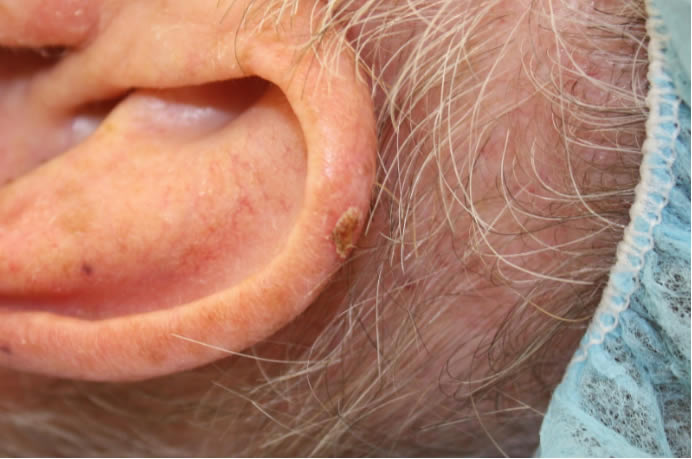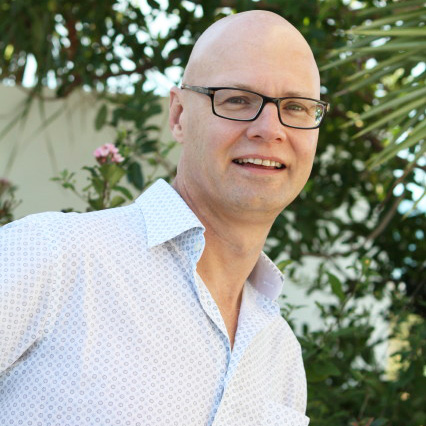WHAT IS SCC CANCER?
Squamous cell carcinoma, also known as SCC, SCC skin cancer or squamous cell cancer is a type of skin cancer. SCC cancer can look like open sores, warts, elevated growths or scaly red patches.
Usually these abnormal growths are found in areas that receive exposure to ultraviolet light, either from the sun or tanning bed lamps, but can develop anywhere. Usually not life-threatening, the condition can become dangerous if it goes untreated. When allowed to grow, SCC cancer can become disfiguring and spread to other parts of your body, causing serious complications.
It is very important to get your skin checked by a qualified dermatologist to identify and treat SCC cancer. If you are looking for SCC skin cancer treatment in Brisbane, contact us so our team can discuss treatment options with you.
WHAT ARE THE DIFFERENT TYPES OF SKIN CANCER?
There are three main types of skin cancer, SCC cancer being the second most common. Your skin has multiple layers with the outer, protective layer of the skin known as the epidermis. The squamous cells, basal cells, and melanocytes are found in this epidermal layer. Skin cancer can occur when a certain genetic change occurs in the DNA of any of these cells.
Squamous Cell Cancer (or SCC Cancer)
Squamous cells are the cells closest to the skin’s surface, and their purpose is to line the skin and aid in barrier function. SCC often develops on areas of the body that are frequently exposed to UV radiation, such as the face, hands, and ears but they can occur anywhere.
Basal Cell Cancer (or BCC Cancer)
Basal cells sit below the squamous cells, and they’re constantly dividing to form new cells. BCC cancer is the most common type of skin cancer. This type of cancer tends to grow slowly, and rarely spreads to other parts of the body, but like SCC cancer, basal cell cancer also mainly develops on areas exposed to UV.
Melanoma
Melanocytes are also located in the basal layer of the epidermis. The cells are responsible for producing the pigment that gives skin its color. Cancer that forms in these cells is known as malignant melanoma. It is less common than SCC or BCC cancer, but it’s more likely to grow and spread when it’s left untreated.
WHAT CAUSES SCC CANCER?
Cancer is caused by mutations that occur in cell DNA. When these changes occur in the squamous skin cells, the condition is known as SCC cancer.
Exposure to ultraviolet radiation (UV) from the sun or tanning bed lamps causes most SCCs. Tanning machines were banned in Australia and Brisbane in January 2015. Experts believed the exposure from these beds was contributing to an increase of skin cancers.
Some subtypes of the human papillomaviruses (wart virus) are thought to cause SCC cancer.
WHERE CAN SCC CANCER BE FOUND?
SCC cancer is most commonly found on the rim of the ear, lower lip, face, balding scalp, neck, hands, arms and legs, and other areas most commonly exposed to the sun. But SCC cancers may occur anywhere, including the mucous membranes, soles of the feet and even genitals.

WHAT ARE THE RISK FACTORS FOR DEVELOPING SCC CANCER AND HOW TO REDUCE THE RISKS?
Minimising your exposure and taking sun safety precautions is in your control and can help prevent SCC cancer.
You may be more susceptible to SCC cancer if you have:
- fair skin and/or light-colored hair and blue, green, or gray eyes
- long-term exposure to UV radiation such as living in sunny Brisbane, Queensland
- a history of multiple severe sunburns, especially if they occurred early in life
- history of being exposed to substances, such as arsenic, coal tars, mineral oils, sunlight
- elderly males are particularly susceptible
- smoking
- actinic keratoses (sunspots)
- areas of skin injury or thermal burns
- immune suppression
- organ transplantation
Regular appointments with a qualified dermatologist for skin examinations will help detect any early presence of SCC cancer.
WHAT DOES SCC CANCER LOOK LIKE?
SCC cancer can present itself as a scaly, reddish patch of skin (known as an intraepidermal carcinoma). As it mutates it can turn into a raised lump that continues to grow or develop as a lump initially. The growth may also crust , bleed or ulcerate. In some cases, you might notice a new growth on a pre-existing scar or birthmark. Any existing lesions or sores that aren’t healing can also indicate SCC cancer.

We strongly suggest making an appointment with us in Brisbane or your doctor if you notice any of these symptoms. Early diagnosis and treatment are critical for preventing complications from SCC cancer.
HOW IS SCC CANCER DIAGNOSED?
SCC cancer is usually diagnosed clinically, however the only way to diagnose any skin cancer, including SCC skin cancer if the diagnosis is uncertain clinically, is with a skin biopsy. During your appointment, your dermatologist will remove a part of the growth or even the entire growth and test it. If the results indicate that you have SCC cancer cells present, your dermatologist will determine the best course of treatment for you.
HOW IS SCC CANCER TREATED?
There are many treatments used for squamous cell carcinoma removal. Your dermatologist recommend the best cure for you depending on your biopsy results. Almost all SCC cancers are surgically excised or by Mohs surgery. Procedures for SCC removal can include:
Excision – This is a simple surgical procedure with no life-threatening risks. During your office visit, your dermatologist will numb the affected area and remove any tumour and some healthy looking skin around a tumour. The importance of eliminating some normal skin from around a tumour is to make sure the healthy skin is free of cancer. The dermatologist checks this by sending the removed skin and healthy skin to the laboratory to be tested just like a biopsy.
Mohs surgery – Mohs micrographic surgery is a highly specialised treatment for the total removal of skin cancers, in which the microscope is used to determine the extent of the tumour and its location. This treatment has the highest cure rate and can be used for SCCs in sensitive areas such as on the face and genitals. During this treatment, the Mohs Specialist will remove a tumour and some normal skin around a tumour. The doctor will check all the margins under a microscope for any cancer signs. This procedure of microscopically assessing the skin margins for cancer cells continues until the dermatologist is sure that you are SCC free. The defect will then require reconstruction by a skin flap or graft.
Radiotherapy – This treatment is used for inoperable tumours or patient’s unable to undergo surgery as well as for adjunctive treatment for aggressive tumours.
Curettage and electrodesiccation – This treatment has two steps. During the first step, the dermatologist scraps away the tumour. In the second step, electricity is used to destroy any remaining SCC cells at the base of the lesion. This option is only used for superficial lesions.
Aesthetix is experienced in these procedures for SCC skin cancer treatment in Brisbane, so contact us to discuss your treatment options.
HOW SUCCESSFUL IS SCC CANCER TREATMENT?
SCC cancer is not usually life-threatening, although it can be aggressive in some cases. The aggressive SCCs can be termed high risk SCC cancer and are historically greater than 2 cms in diameter, 2 mm in depth. They can be present on the head, hands and feet or genitals, or in patients who have immunosuppressed. These high risk SCC cancers are more likely to recur and/or spread, so your dermatologist may recommend further investigations in these instances. This is known as staging.
Early detection and treatment can see a patient recovering fully with a very low incidence of the cancer returning.
Mohs surgery, which is available in Brisbane, has the highest cure rate of various SCC cancer treatment solutions. It’s especially useful for squamous cell cancers larger than 2cm in diameter or with poorly defined edges, for cancers that have returned, for cancers that are spreading along nerves under the skin, and for cancers on certain sensitive areas of the body such as the face or genitals.
WHAT CAN BE EXPECTED AFTER SCC CANCER SURGERY?
Bruising and swelling are common side effects of any surgery though they generally resolve within a few weeks.
After the surgery, you may see some scarring. However, this scar will become less noticeable over time. It is essential to follow the post-operative care instructions given to you by your dermatologist.
Make sure you regularly visit your dermatologist to make sure you are healing correctly and to monitor for signs of recurrence. A post operative review programme will be arranged.
READY TO DISCUSS SCC CANCER REMOVAL?
For a confidential discussion on our SCC cancer removal procedures, please contact us on 07 3720 8788 or make an enquiry online. We look forward to speaking with you.

NEW Sunscreen Product
Dr Hills has developed a Zinc Oxide sunscreen containing no chemical sunscreen. Our Aesthetix Sunscreen is available in standard and tinted, and is available for purchase at Dr Hills rooms or you can buy it from our online shop.
 Dr Russell Hills is an experienced cosmetic dermatologist based in Brisbane, Australia and is a member of the Academy of Facial Plastic Surgery. Dr Hills also has extensive experience in MOHS surgery for skin cancer removal, and is the principal Dermatologist at Aesthetix.
Dr Russell Hills is an experienced cosmetic dermatologist based in Brisbane, Australia and is a member of the Academy of Facial Plastic Surgery. Dr Hills also has extensive experience in MOHS surgery for skin cancer removal, and is the principal Dermatologist at Aesthetix.
Dr Hills regularly lectures on cosmetic and laser surgery and skin cancer removal, and has numerous publications on these topics. He is a member of a number of Australian and American medical associations, and attends local and international conferences to stay up-to-date with the latest approaches in cosmetic medicine.
Adherence to the information on this site will not ensure successful treatment in every situation and will not ensure specific results in the individual patient. Although complications may be rare, there are certain inherent risks connected with surgical procedures that should be discussed with the dermatologist. This Website contains very general information and any procedures mentioned in it should be discussed in detail with your dermatologist at the time of consultation.
